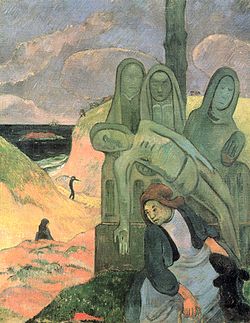The Green Christ
| The Green Christ | |
|---|---|
 | |
| Artist | Paul Gauguin |
| Year | 1889 |
| Medium | Oil on canvas |
| Dimensions | 92 cm × 73 cm (36.2 in × 28.7 in) |
| Location | Royal Museums of Fine Arts of Belgium, Brussels |
The Green Christ (in French: Le Christ vert) is an oil on canvas painting executed by Paul Gauguin in the Autumn of 1889 in Pont-Aven, Brittany. Together with The Yellow Christ, it is considered to be one of the key-works of Symbolism in painting. It depicts a Breton woman at the foot of a calvary, or sculpture of Christ's crucifixion. Calvaries are common in town squares in Brittany. The woman appears to be hiding from a pair of figures in the distant background; the green Christ providing her cover from these people.
Topographically, the site depicted is the Atlantic coast at Le Pouldu. But the calvary depicted is an amalgam of several calvaries from different places; the cross is based upon that in the centre of Névez, a community close to Pont-Aven, located several miles from the coast, and the figure of Christ is based upon the calvarie at Briec, also at some distance from the sea.[1][2][3]
See also[edit]
References[edit]
- ^ Dario Gamboni, Paul Gauguin: The Mysterious Centre of Thought, Reaktion Books, 2014, pp. 135, 157, 280, 281
- ^ Jean-François Staszak, Géographies de Gauguin, Editions Bréal, 2003 (French), ISBN 2749520754, 9782749520759, pp. 47-48
- ^ Catherine Puget, Peintres de la Bretagne et quête spirituelle, Musée de Pont Aven, 2006 (French), pp. 9, 25, 48
